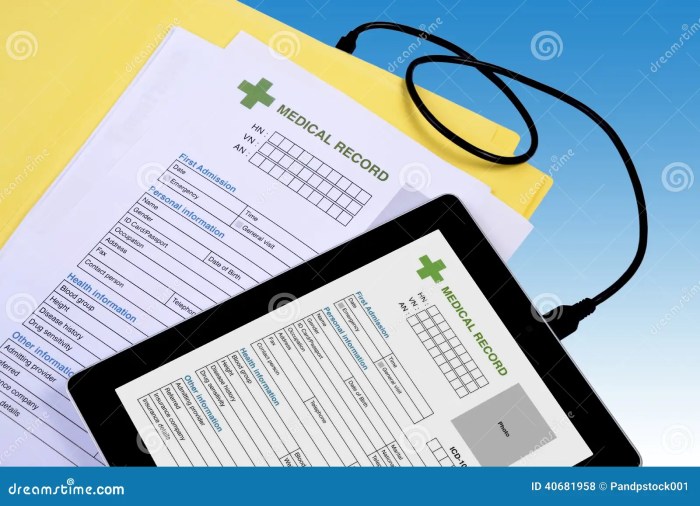
Embark on a journey to seamlessly transfer your health records to a new doctor with this comprehensive guide. Delve into the intricacies of the process and empower yourself with valuable insights to ensure a smooth transition in your healthcare journey.
Overview of Health Record Transfer Process

When changing doctors, it is crucial to transfer your health records to ensure seamless continuity of care. This process involves sending your medical history, test results, treatment plans, and other relevant information from your previous healthcare provider to your new doctor.
Importance of Transferring Health Records
- Allows your new doctor to have a comprehensive understanding of your medical history and current health status.
- Helps in making informed decisions about your treatment plan, medications, and follow-up care.
- Ensures that important details are not missed out and prevents errors in diagnosis or treatment.
Potential Consequences of Not Transferring Health Records
- Delayed or incorrect diagnosis due to lack of crucial information.
- Repetition of tests or procedures that have already been done, leading to unnecessary costs and inconvenience.
- Risk of adverse drug interactions or allergic reactions if your new doctor is unaware of your medical history.
Situations Where Transferring Health Records is Crucial
- Transitioning between primary care physicians or specialists for ongoing treatment.
- Seeking a second opinion from a different healthcare provider.
- Relocating to a new city or country and needing to establish care with a new doctor.
Methods for Transferring Health Records
Transferring your health records to a new doctor is essential for ensuring continuity of care and proper treatment. There are several methods available to facilitate this process, including requesting records from your current healthcare provider and choosing the format for transfer.
Requesting Health Records from Current Healthcare Provider
When transferring health records to a new doctor, the first step is to request your records from your current healthcare provider. This can usually be done by submitting a written request to the medical records department of the facility. Make sure to include your full name, date of birth, contact information, and the name of the new doctor or facility where the records need to be sent.After submitting your request, the healthcare provider may require you to fill out a release form to authorize the transfer of your health records.
Once the request is processed, you can choose the format in which you want your records to be transferred.
Different Formats for Health Record Transfer
Health records can be transferred in various formats, including electronically, via mail, or in-person. Electronic transfer is becoming increasingly common and allows for quick and efficient sharing of records between healthcare providers. This method is secure and ensures that your records reach the new doctor promptly.On the other hand, physical health records can be transferred via mail or in-person. This process may take longer and is subject to delays in delivery.
However, some patients prefer physical copies of their records for their own records or peace of mind.
Physical Health Records vs. Electronic Health Records
Transferring physical health records involves printing out copies of your medical history, test results, and other relevant information. These records are then sealed and sent via mail or handed over in-person. This method can be time-consuming and may incur additional costs for printing and postage.Electronic health records, on the other hand, are transferred digitally through secure platforms or email. This method is faster, more convenient, and reduces the risk of errors or loss of information during transfer.
Additionally, electronic records are easier to update and access by healthcare providers, ensuring accurate and up-to-date information for your new doctor.
Legal and Privacy Considerations

When it comes to transferring health records between healthcare providers, there are important legal and privacy considerations that must be taken into account to protect patient information and ensure compliance with regulations.
Laws and Regulations
- Health Insurance Portability and Accountability Act (HIPAA): HIPAA establishes national standards for the protection of certain health information and requires healthcare providers to secure patient data during transfer.
- State Laws: Some states have additional regulations regarding the transfer of health records, such as specific consent requirements or limitations on the use of electronic health records.
Importance of Patient Consent
- Obtaining patient consent is crucial before transferring health records to a new doctor. Patients have the right to control who has access to their medical information and must give explicit permission for its disclosure.
- Without proper consent, healthcare providers risk violating patient privacy and facing legal consequences for unauthorized access to sensitive health data.
Risks of Unauthorized Access
- Unauthorized access to health records during the transfer process can lead to breaches of patient confidentiality, identity theft, or exposure of sensitive medical conditions.
- Healthcare providers must implement secure transmission methods and data encryption to prevent unauthorized parties from intercepting or accessing patient records.
Benefits of Efficient Health Record Transfer
Transferring health records to a new doctor can significantly improve the quality of care you receive. By having access to your complete medical history, healthcare providers can make more informed decisions about your treatment plan and overall health management. This seamless transfer of health records ensures that vital information is readily available, leading to better health outcomes for patients.
Improved Continuity of Care
- Access to complete health records allows new doctors to understand your medical history, past treatments, and any ongoing health concerns.
- Providers can avoid redundant tests or procedures and tailor treatment plans based on your unique health needs.
Enhanced Communication Among Healthcare Providers
- Efficient health record transfer ensures that all members of your healthcare team are on the same page regarding your health status and treatment plan.
- Collaboration between specialists, primary care physicians, and other healthcare professionals becomes smoother, leading to coordinated care.
Prevention of Medication Errors
- Having access to accurate medication lists and allergy information helps healthcare providers prevent medication errors and adverse drug reactions.
- Providers can make informed decisions about prescribing new medications or adjusting dosages based on your medical history.
Challenges in Health Record Transfer
Transferring health records to a new doctor can present various challenges for patients. These challenges can range from logistical issues to technical complications, making the process seem daunting. However, with the right strategies and tips, patients can overcome these obstacles and ensure a smooth transfer of their health records.
Costs Associated with Transfer
One of the major challenges patients face when transferring health records is the cost involved. Some healthcare providers may charge a fee for copying and transferring records to a new doctor, which can be a financial burden for patients.
Time Constraints
Another common challenge is the time constraints associated with transferring health records. The process can be time-consuming, requiring patients to fill out paperwork, follow up with providers, and wait for records to be transferred. This can delay the continuity of care and impact the patient’s treatment plan.
Technical Issues
Technical issues such as incompatible electronic health record systems or data format discrepancies can also hinder the transfer process. This can lead to errors in the transferred records or even loss of important medical information.
Strategies for Overcoming Challenges
- Plan ahead and start the transfer process well in advance to avoid any last-minute rush.
- Discuss potential costs with both the current and new healthcare providers to understand the fees involved.
- Request electronic copies of your health records to simplify the transfer process and reduce the risk of data format issues.
- Follow up with providers regularly to ensure the timely transfer of records and address any issues promptly.
Role of Electronic Health Records (EHR) Systems
Electronic Health Records (EHR) systems have significantly revolutionized the process of transferring health records in the medical field. These systems have brought about a digital transformation, making the exchange of health information more efficient and secure than traditional paper-based methods.
Benefits of EHR Systems in Ensuring Secure and Efficient Transfer of Health Records
- Enhanced Accessibility: EHR systems allow healthcare providers to access patient records quickly and securely, regardless of their physical location. This accessibility facilitates the seamless transfer of health records between different medical professionals.
- Improved Coordination of Care: With EHR systems, healthcare providers can easily share patient information, test results, and treatment plans in real-time. This streamlined communication enhances the coordination of care among different healthcare teams involved in a patient’s treatment.
- Enhanced Data Security: EHR systems employ advanced security measures to protect sensitive patient information from unauthorized access or breaches. This ensures that health records are transferred securely, maintaining patient confidentiality and privacy.
Examples of How EHR Systems Have Improved Healthcare Access and Coordination
- Telemedicine Integration: EHR systems enable the integration of telemedicine services, allowing patients to connect with healthcare providers remotely. This integration enhances access to healthcare services, especially in rural or underserved areas.
- Interoperability: EHR systems promote interoperability, enabling different healthcare facilities to exchange patient data seamlessly. This interoperability improves care coordination and reduces the likelihood of medical errors due to incomplete information.
- Mobile Health Applications: EHR systems support the development of mobile health applications that empower patients to access their health records, schedule appointments, and communicate with their healthcare providers. These applications enhance patient engagement and promote proactive healthcare management.
In conclusion, navigating the transfer of health records to a new doctor is a vital step in maintaining continuity of care. By understanding the process, you can proactively manage your health information and enhance the quality of healthcare you receive. Take charge of your medical records and pave the way for improved health outcomes.
Query Resolution
How long does it typically take to transfer health records to a new doctor?
The time frame for transferring health records can vary, but it usually takes a few weeks to complete the process, depending on the healthcare provider’s policies and procedures.
Is there a fee associated with transferring health records?
Some healthcare providers may charge a nominal fee for transferring health records, so it’s advisable to inquire about any associated costs beforehand.







